A Novel Reconstruction Approach to Elevator Energy Conservation Based on a DC Micro-Grid in High-Rise Buildings
Abstract
:1. Introduction
1.1. Major Methods of Elevator Energy Conservation
1.2. The Utilization of Elevator Regeneration Energy
1.3. The Framework of the Article
2. Methodology
2.1. The Characteristics of the Running State of an Elevator
2.2. A New Energy-Efficient Method Proposed for Elevator Group
2.3. The Essential Issue of the Proposed Method for Elevator Groups
3. Design of an Elevator Energy-Efficient Device Based on a Supercapacitor
3.1. Method of Engineering
3.2. Design Principle of an Elevator Group Energy-Efficient Device
4. Case Study
4.1. The Reconstruction of Elevator Group
4.2. The Analysis of the Test Experiment Data
4.3. The Analysis of the Actual Operation Data
4.4. The Analysis of Test Experiment and Actual Operation Data
4.5. The Transverse Comparison of the Energy-Efficient Rate
5. Conclusion and Prospects
Author Contributions
Funding
Acknowledgments
Conflicts of Interest
Nomenclature
| AC | Alternating Current |
| BAS | Building Automation System |
| DC | Direct Current |
| DCE | Double Car Elevator |
| IoT | Internet of Things |
| VFD | Variable Frequency Drive |
| VVVF | Variable Voltage and Variable Frequency |
References
- Barney, G.C.; Dos Santos, S.M. Elevator Traffic Analysis, Design and Control, 2nd ed.; Institution of Engineering and Technology: London, UK, 1985; ISBN 9780863410420. [Google Scholar]
- CIBSE Guide D: Transportation Systems in Buildings, 4th ed.; CIBSE Pub.: London, UK, 2010; ISBN 978-1906846169.
- Barney, G.C.; Al-Sharif, L. Elevator Traffic Handbook: Theory and Practice, 2nd ed.; Routledge Pub.: Abingdon, UK, 2015; 440p, ISBN 9781138852327. [Google Scholar]
- So, A.T.P.; Liu, S.K. An Overall Review of advanced elevator Technologies. Elevat. World 1996, 44, 96–101. [Google Scholar]
- Wang, D.H.; Cheng, K.W.E. General discussion on energy saving. In Proceedings of the 1st International Conference on Power Electronics Systems and Applications, Hong Kong, China, 9–11 November 2004; pp. 298–303. [Google Scholar]
- Ganga, D.; Ramachandran, V. IoT based Vibration Analytics of Electrical Machines. IEEE Internet Things J. 2018, 1, 1–12. [Google Scholar] [CrossRef]
- González, I.; Calderón, A.J.; Mejías, A.; Andújar, J.M. Novel Networked Remote Laboratory Architecture for Open Connectivity Based on PLC-OPC-LabVIEW-EJS Integration. Application in Remote Fuzzy Control and Sensors Data Acquisition. Sensors 2016, 16, 1822. [Google Scholar] [CrossRef] [PubMed]
- Kande, M.; Isaksson, A.J.; Thottappillil, R.; Taylor, N. Rotating Electrical Machine Condition Monitoring Automation—A Review. Machines 2017, 5, 24. [Google Scholar] [CrossRef]
- Saponara, S. Distributed Measuring System for Predictive Diagnosis of Uninterruptible Power Supplies in Safety-Critical Applications. Energies 2016, 9, 327. [Google Scholar] [CrossRef]
- Saponara, S.; Fanucci, L.; Bernardo, F.; Falciani, A. Predictive diagnosis of high-power transformer faults by networking vibration measuring nodes with integrated signal processing. IEEE Trans. Instrum. Meas. 2016, 65, 1749–1760. [Google Scholar] [CrossRef]
- Zhou, S.-Z.; Li, X.; Chen, G.; Hu, S. A Piecewise Control Strategy for a Bidirectional Series Resonant Converter. Electronics 2018, 7, 374. [Google Scholar] [CrossRef]
- Tukia, T.; Uimonen, S.; Siikonen, M.L.; Donghi, C.; Lehtonen, M. High-resolution modeling of elevator power consumption. J. Build. Eng. 2018, 18, 210–219. [Google Scholar] [CrossRef]
- Yu, L.; Zhou, J.; Mabu, S.; Shimada, K.; Hirasawa, K.; Markon, S. Multi-Car Elevator System using Genetic Network Programming. In Proceedings of the IEEE International Conference on Systems Man and Cybernetics, Tokyo, Japan, 20–22 August 2008. [Google Scholar]
- Ikeda, K.; Suzuki, H.; Markon, S.; Kita, H. Designing traffic-sensitive controllers for multi-car elevators through evolutionary multi-objective optimization. In Proceedings of the International Conference on Evolutionary Multi-Criterion Optimization, Matsushima, Japan, 5–8 March 2007; pp. 673–686. [Google Scholar]
- Yue, Y.T.; Wang, G.Z.; Kou, Z.Y. Study on Key Technologies of High-speed Elevators for Extra-high Buildings. Build. Electr. 2015, 5, 35–38. (In Chinese) [Google Scholar] [CrossRef]
- Ding, B.; Li, Q.C.; Zhang, Y.M.; Zhang, J.; Qi, W.G. Traffic mode prediction method for twin elevator group control system. J. Harbin Inst. Technol. 2013, 45, 79–83. (In Chinese) [Google Scholar] [CrossRef]
- Ding, B.; Zhang, Y.M.; Peng, X.Y.; Li, Q.C.; Tang, H.Y. A Hybrid Approach for the Analysis and Prediction of Elevator Passenger Flow in an Office Building. Autom. Constr. 2013, 35, 69–78. [Google Scholar] [CrossRef]
- Tang, H.Y.; Ding, B.; Qi, W.G. Study on optimal scheduling of multi control policy for elevator group. Trans. China Electrotech. Soc. 2007, 22, 179–183. (In Chinese) [Google Scholar]
- Bolat, B.; Altun, O.; Cortés, P. A particle swarm optimization algorithm for optimal car-call allocation in elevator group control systems. Appl. Soft Comput. 2013, 13, 2633–2642. [Google Scholar] [CrossRef] [Green Version]
- Cortés, P.; Onieva, L.; Muñuzuri, J.; Guadix, J. A viral system algorithm to optimize the car dispatching in elevator group control systems of tall buildings. Comput. Ind. Eng. 2013, 64, 403–411. [Google Scholar] [CrossRef] [Green Version]
- Zhang, J.L.; Zong, Q. Energy-saving scheduling optimization under up-peak traffic for group elevator system in building. Energy Build. 2013, 66, 495–504. [Google Scholar] [CrossRef]
- Kwon, O.; Lee, E.; Bahn, H. Sensor-aware elevator scheduling for smart building environments. Build. Environ. 2014, 72, 332–342. [Google Scholar] [CrossRef]
- Ahmed, S.S.; Iqbal, A.; Sarwar, R.; Salam, M.S. Modeling the energy consumption of a lift. Energy Build. 2014, 71, 61–67. [Google Scholar] [CrossRef]
- Liao, Y.J.; Liao, G.X.; Lo, S.M. Influencing factor analysis of ultra-tall building elevator evacuation. Procedia Eng. 2014, 71, 583–590. [Google Scholar] [CrossRef]
- Esteban, E.; Salgado, O.; Iturrospe, A.; Isasa, I. Model-based approach for elevator performance estimation. Mech. Syst. Signal Process. 2016, 68–69, 125–137. [Google Scholar] [CrossRef]
- Adak, M.F.; Duru, N.; Duru, H.T. Elevator simulator design and estimating energy consumption of an elevator system. Energy Build. 2013, 65, 272–280. [Google Scholar] [CrossRef]
- Tukia, T.; Uimonen, S.; Siikonen, M.L.; Hakala, H.; Donghi, C.; Lehtonen, M. Explicit method to predict annual elevator energy consumption in recurring passenger traffic conditions. J. Build. Eng. 2016, 8, 179–188. [Google Scholar] [CrossRef]
- Schofield, A.J.; Stonham, T.J.; Mehta, P.A. Automated people counting to aid lift control. Autom. Constr. 1997, 6, 437–445. [Google Scholar] [CrossRef]
- Lee, M.; Kim, T.; Jung, H.K.; Lee, U.K.; Cho, H.; Kang, K.I. Green construction hoist with customized energy regeneration system. Autom. Constr. 2014, 45, 66–71. [Google Scholar] [CrossRef]
- Minav, T.A.; Virtanen, A.; Laurila, L.; Pyrhönen, J. Storage of energy recovered from an industrial forklift. Autom. Constr. 2012, 22, 506–515. [Google Scholar] [CrossRef]
- Zhang, T.; Mabu, S.; Yu, L.; Zhou, J. Energy saving elevator group supervisory control system with Idle Cage Assignment using Genetic Network Programming. In Proceedings of the 2009 ICCAS-SICE, Fukuoka, Japan, 18–21 August 2009. [Google Scholar]
- Liu, Y.; Hu, Z.; Su, Q.; Huo, J. Energy Saving of Elevator Group Control Based on Optimal Zoning Strategy with Interfloor Traffic. In Proceedings of the 3rd International Conference on Information Management Innovation Management and Industrial Engineering, Kunming, China, 26–28 November 2010. [Google Scholar]
- Zhang, J.L.; Jie, T.; Zong, Q.; Li, J.F. Energy-saving scheduling strategy for elevator group control system based on ant colony optimization. In Proceedings of the 2010 IEEE Youth Conference on Information Computing and Telecommunications, Beijing, China, 28–30 November 2010. [Google Scholar]
- Marsong, S.; Plangklang, B. Implementation analysis of an elevator energy regenerative unit (EERU) for energy saving in a building. In Proceedings of the 2016 13th International Conference on Electrical Engineering/Electronics, Computer, Telecommunications and Information Technology (ECTI-CON), Chiang Mai, Thailand, 28 June–1 July 2016. [Google Scholar]
- D’Adamo, I. The Profitability of Residential Photovoltaic Systems. A New Scheme of Subsidies Based on the Price of CO2 in a Developed PV Market. Soc. Sci. 2018, 7, 148. [Google Scholar] [CrossRef]
- Wang, Y.H.; Li, Y.; Cao, Y.J.; Tan, Y.; Li, H.; Han, J.Y. Hybrid AC/DC microgrid architecture with comprehensive control strategy for energy management of smart building. Int. J. Electr. Power Energy Syst. 2018, 101, 151–161. [Google Scholar] [CrossRef]
- Tony, C.C.; Macarulla, A.M.; Kamara-Esteban, O.; Borges, C.E. Analysis and assessment of an off-grid services building through the usage of a DC photovoltaic microgrid. Sustain. Cities Soc. 2018, 38, 405–419. [Google Scholar] [CrossRef]
- Kubade, P.; Umathe, S.K. Enhancing an elevator efficiency by using supercapacitor. In Proceedings of the 2017 Third International Conference on Advances in Electrical, Electronics, Information, Communication and Bio-Informatics, Chennai, India, 27–28 February 2017. [Google Scholar]
- Mathew, S.; Mogre, P.; Chouthai, R.; Karandikar, P.B.; Kulkarni, N.R. Supercapacitor based energy recovery system for an elevator. In Proceedings of the 2017 International Conference on Advances in Computing, Communication and Control, Mumbai, India, 1–2 December 2017. [Google Scholar]
- Jabbour, N.; Mademlis, C. Supercapacitor-based energy recovery system with improved power control and energy management for elevator applications. IEEE Trans. Power Electron. 2017, 32, 9389–9399. [Google Scholar] [CrossRef]
- Liu, H.P.; Liu, K.; Sun, B.N. Analysis of energy management strategy for energy-storage type elevator based on supercapacitor. In Proceedings of the 2017 11th IEEE International Conference on Compatibility, Power Electronics and Power Engineering, Cadiz, Spain, 4–6 April 2017. [Google Scholar]
- Braslavsky, I.; Plotnikov, I.; Ishmatov, Z.; Polunin, F. The estimation of technical and economic efficiency of using the supercapacitors in the hoisting applications. In Proceedings of the 2014 International Symposium on Power Electronics, Electrical Drives, Automation and Motion, Ischia, Italy, 18–20 June 2014. [Google Scholar]
- Li, Z.; Ruan, Y. A Novel Energy Saving Control System for Elevator Based on, Supercapacitor Bank Using Fuzzy Logic. In Proceedings of the 2008 International Conference on Electrical Machines and Systems, Wuhan, China, 17–20 October 2008. [Google Scholar]
- Kafalis, K.; Karlis, A.D. Supercapacitors based energy saving mode of electromechanical elevator’s operation. In Proceedings of the 2016 XXII International Conference on Electrical Machines, Lausanne, Switzerland, 4–7 September 2016. [Google Scholar]
- Huang, B.C. Elevator energy-efficient control system of shared DC bus. Build. Electr. 2007, 7, 8–10. (In Chinese) [Google Scholar] [CrossRef]
- Zhang, Y.M.; Fu, W.D.; Ding, B.; Liu, Q. Electrical energy conservation based on DC distribution and DC microgrid. Trans. China Electrotech. Soc. 2015, 30, 389–397. (In Chinese) [Google Scholar] [CrossRef]
- Zhang, Y.M.; Yan, Z.; Li, L.; Yao, J.W. A Hybrid Building Power Distribution System in Consideration of Supply and Demand-Side: A Short Overview and a Case Study. Energies 2018, 11, 3082. [Google Scholar] [CrossRef]
- Cha, H.J.; Won, D.J.; Kim, S.H.; Chung, I.Y.; Han, B.-M. Multi-Agent System-Based Microgrid Operation Strategy for Demand Response. Energies 2015, 8, 14272–14286. [Google Scholar] [CrossRef] [Green Version]
- Huang, W.T.; Chen, T.H.; Chen, H.T.; Yang, J.S.; Lian, K.L.; Chang, Y.R.; Lee, Y.D.; Ho, Y.H. A Two-stage Optimal Network Reconfiguration Approach for Minimizing Energy Loss of Distribution Networks Using Particle Swarm Optimization Algorithm. Energies 2015, 8, 13894–13910. [Google Scholar] [CrossRef] [Green Version]
- Elena Dragomir, O.; Dragomir, F.; Stefan, V.; Minca, E. Adaptive Neuro-Fuzzy Inference Systems as a Strategy for Predicting and Controling the Energy Produced from Renewable Sources. Energies 2015, 8, 13047–13061. [Google Scholar] [CrossRef] [Green Version]
- Sanseverino, E.R.; Di Silvestre, M.L.; Badalamenti, R.; Nguyen, N.Q.; Guerrero, J.M.; Meng, L. Optimal Power Flow in Islanded Microgrids Using a Simple Distributed Algorithm. Energies 2015, 8, 11493–11514. [Google Scholar] [CrossRef] [Green Version]
- Thangavelu, S.R.; Nutkani, I.U.; Hwee, C.M.; Myat, A.; Khambadkone, A. Integrated Electrical and Thermal Grid Facility—Testing of Future Microgrid Technologies. Energies 2015, 8, 10082–10105. [Google Scholar] [CrossRef]
- Yao, J.; Zhang, Y.; Yan, Z.; Li, L. A Group Approach of Smart Hybrid Poles with Renewable Energy, Street Lighting and EV Charging Based on DC Micro-Grid. Energies 2018, 11, 3445. [Google Scholar] [CrossRef]


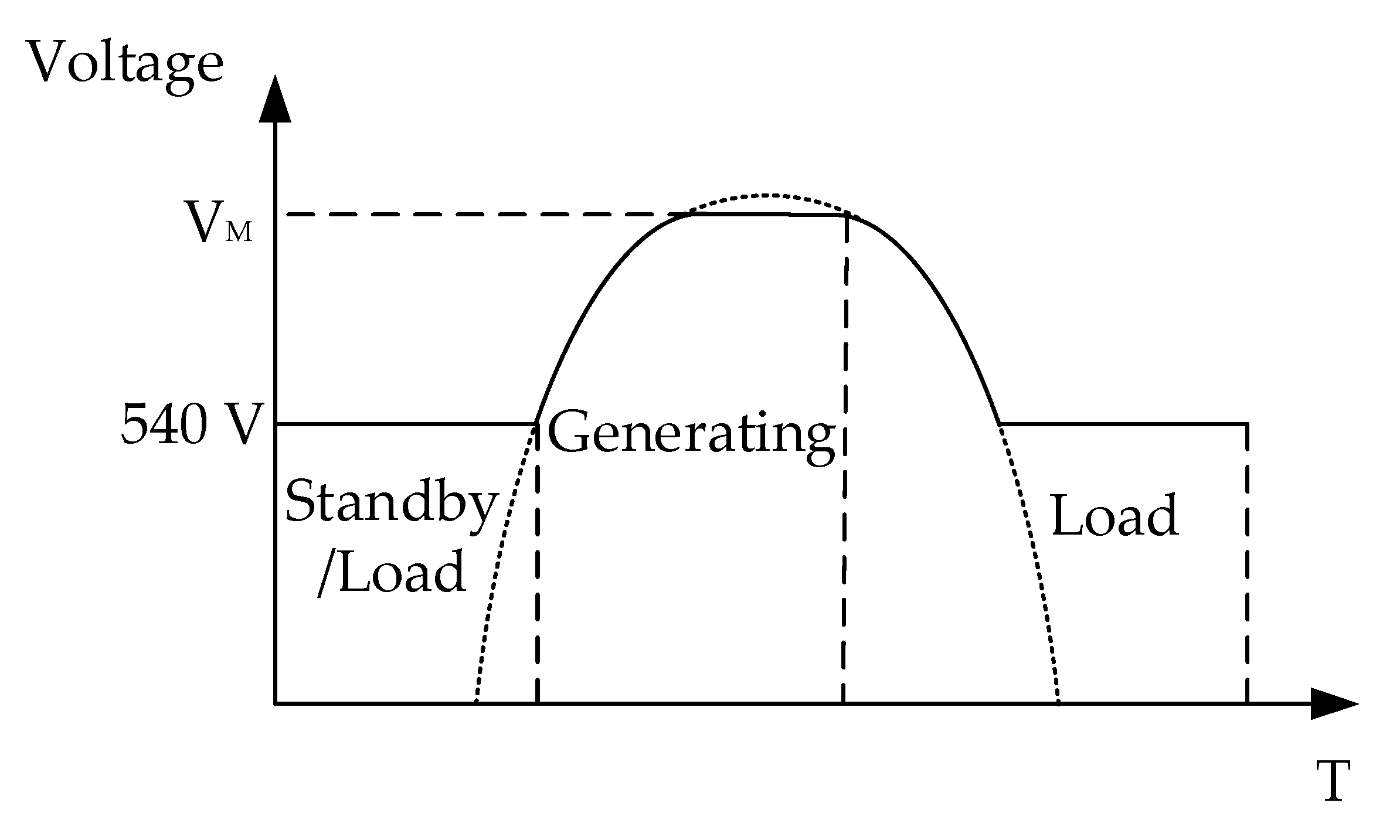



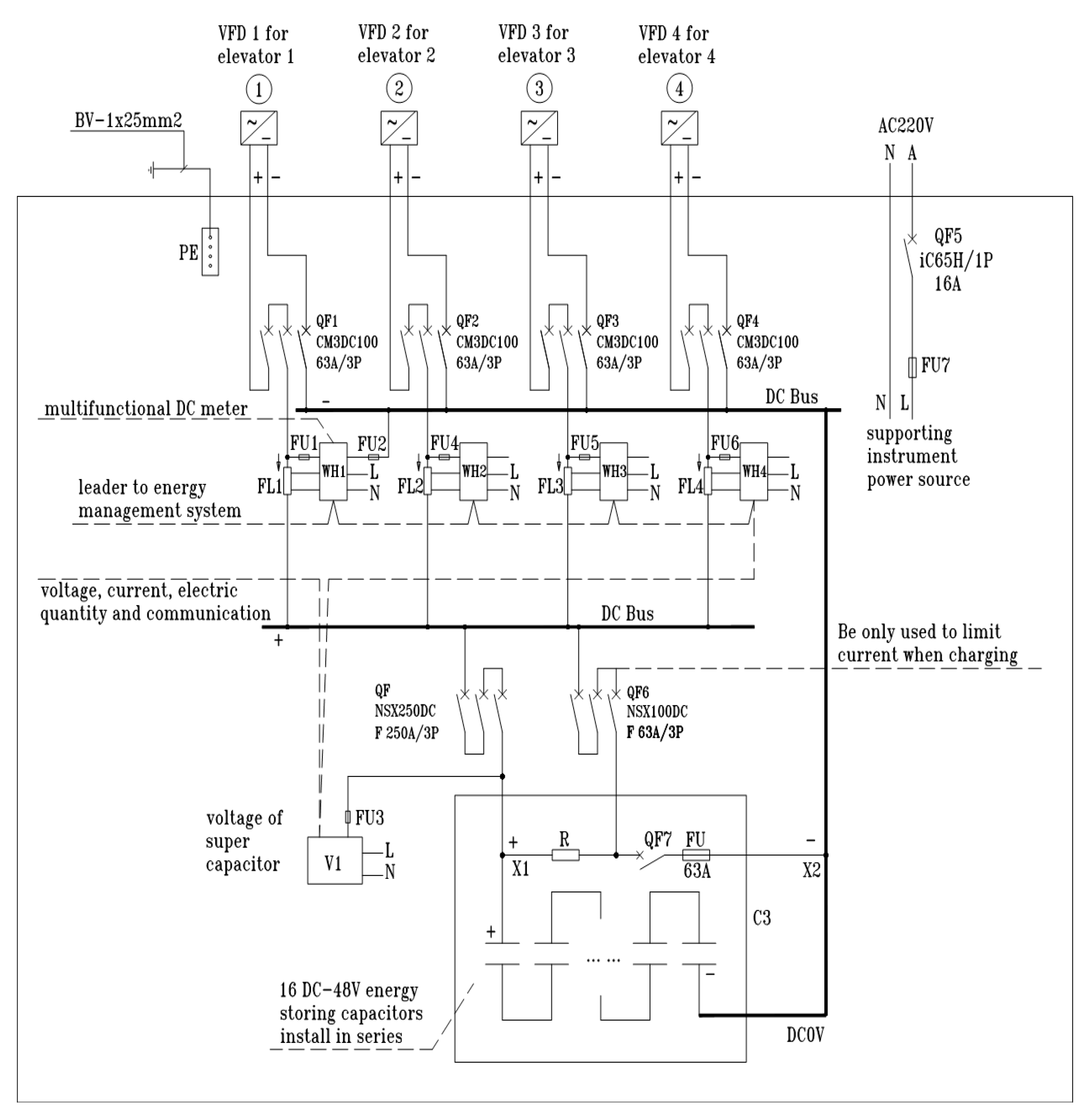


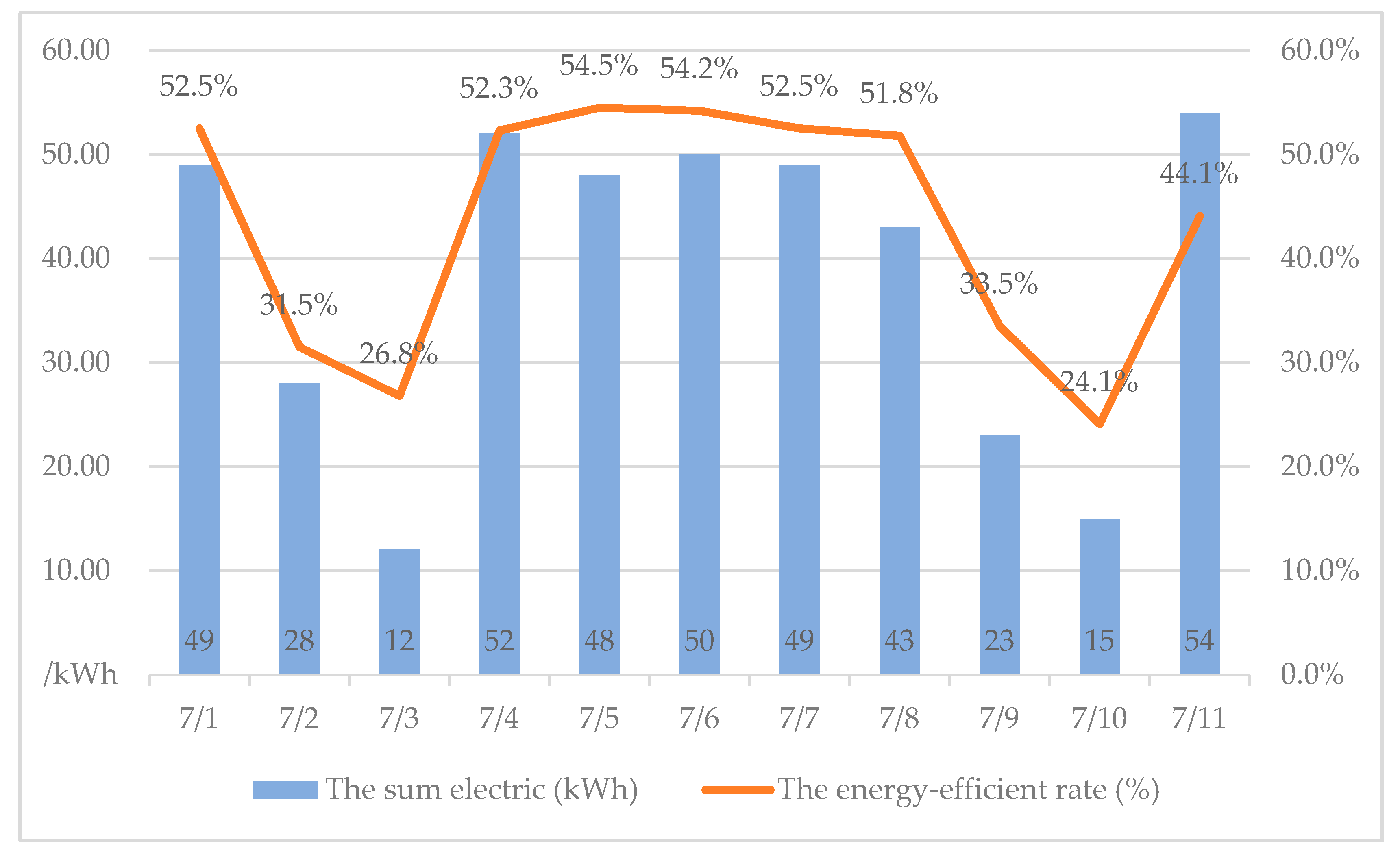
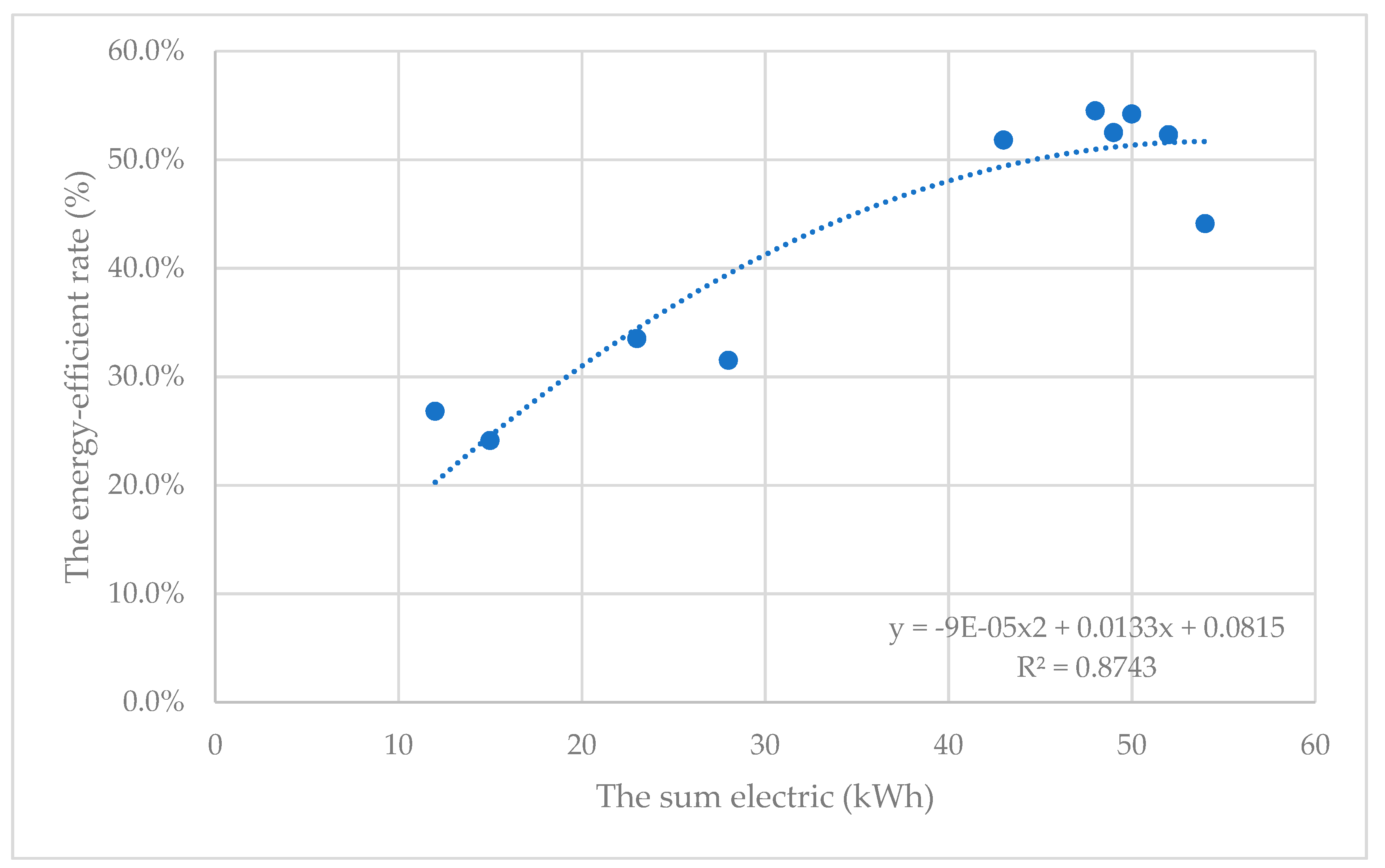
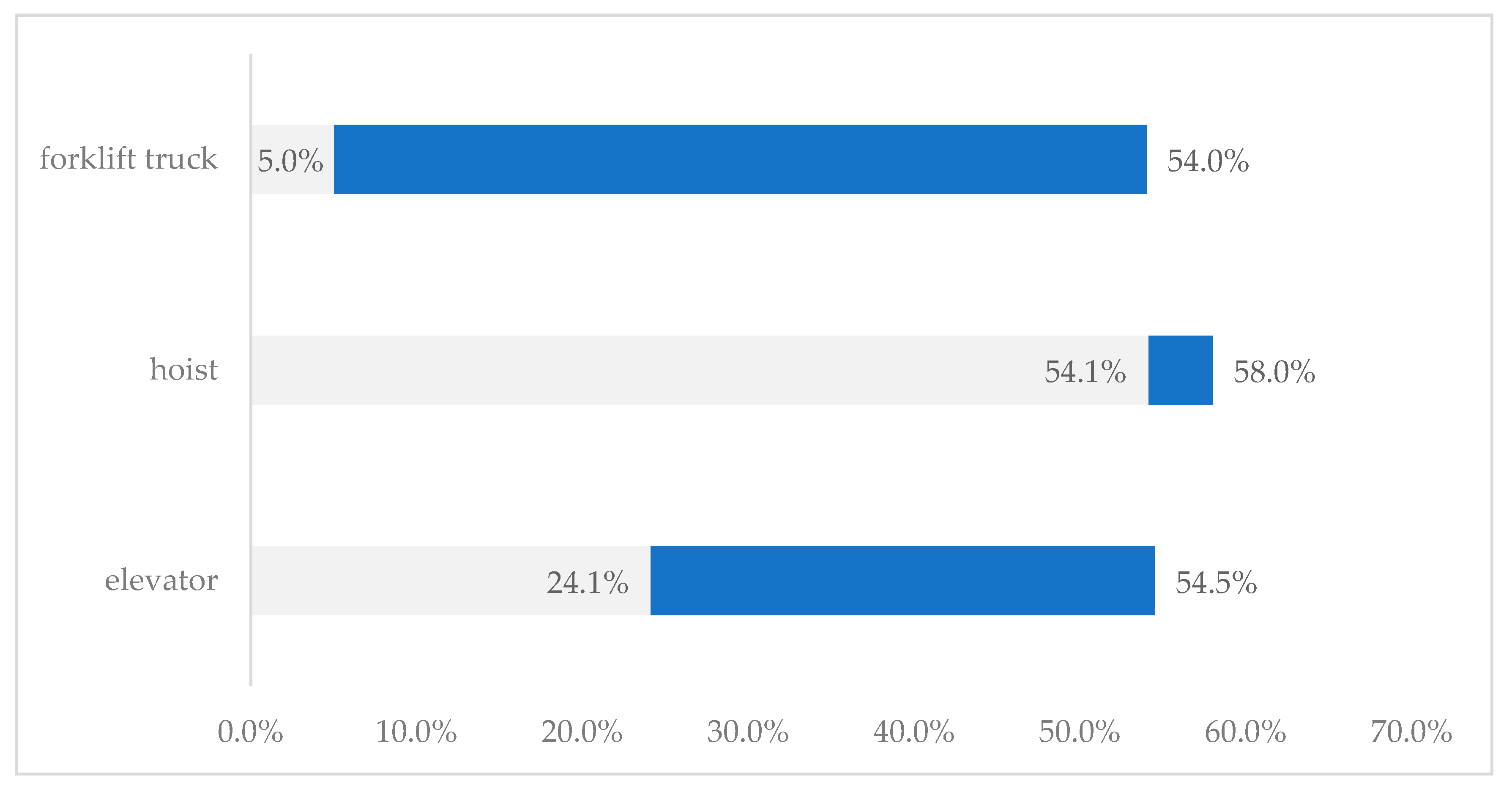
© 2018 by the authors. Licensee MDPI, Basel, Switzerland. This article is an open access article distributed under the terms and conditions of the Creative Commons Attribution (CC BY) license (http://creativecommons.org/licenses/by/4.0/).
Share and Cite
Zhang, Y.; Yan, Z.; Yuan, F.; Yao, J.; Ding, B. A Novel Reconstruction Approach to Elevator Energy Conservation Based on a DC Micro-Grid in High-Rise Buildings. Energies 2019, 12, 33. https://doi.org/10.3390/en12010033
Zhang Y, Yan Z, Yuan F, Yao J, Ding B. A Novel Reconstruction Approach to Elevator Energy Conservation Based on a DC Micro-Grid in High-Rise Buildings. Energies. 2019; 12(1):33. https://doi.org/10.3390/en12010033
Chicago/Turabian StyleZhang, Yongming, Zhe Yan, Feng Yuan, Jiawei Yao, and Bao Ding. 2019. "A Novel Reconstruction Approach to Elevator Energy Conservation Based on a DC Micro-Grid in High-Rise Buildings" Energies 12, no. 1: 33. https://doi.org/10.3390/en12010033



